The Garden Development Story
Below are the garden sections taken from the annual reviews that may be found in their entirety elsewhere on the domain. Click on any picture to see a larger scale version. The pictures open in a new window so just close it when finished. As you scroll down a 'return to the top' button will appear in the lower right corner of the screen.
2015/16
The garden was worked on continuously but with a strong sense of 'wait and see' in case something hidden from view made an appearance. That didn't mean there was not much to do as all 6,800 m² were overgrown with brambles, nettles and ivy with some trees that our neighbour had wanted down for years and a beech hedge which was becoming a forest. Even the shrubs and trees were running wild and needed severe pruning.
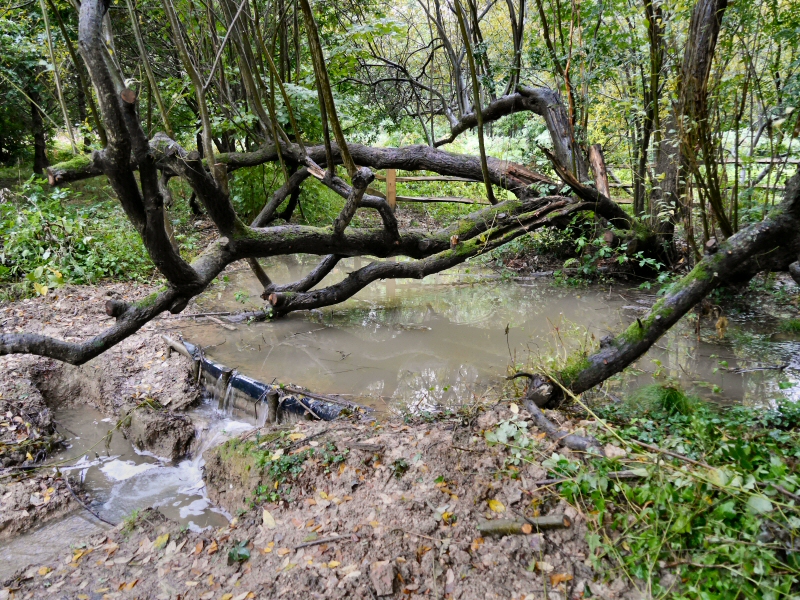 The Diocese had divided the glebe land, giving some to the school just up the road. We had an obligation to erect a fence [just over 100 metres of it] along the new boundary under the terms of our purchase agreement. About one third of the way along the route was an old crack willow with a breached dam that had formed a pond once upon a time. In discussion with the school we agreed to route the fence around the tree and to reinstate the dam so that the school had an additional teaching aid, a wild life pond. The fence was erected in May but there was only a temporary dam, the permanent one would have to wait for the summer of 2016.
The Diocese had divided the glebe land, giving some to the school just up the road. We had an obligation to erect a fence [just over 100 metres of it] along the new boundary under the terms of our purchase agreement. About one third of the way along the route was an old crack willow with a breached dam that had formed a pond once upon a time. In discussion with the school we agreed to route the fence around the tree and to reinstate the dam so that the school had an additional teaching aid, a wild life pond. The fence was erected in May but there was only a temporary dam, the permanent one would have to wait for the summer of 2016.
 In total about 10 trees were taken down along the western boundary of the home garden, some by a professional and some by ourselves. In addition, we took out about 10 metres of the holly mess [it was probably a hedge once upon a time] between the home garden and the glebe land and freed the oak tree in that area of the large ivy that was slowly strangling it.
In total about 10 trees were taken down along the western boundary of the home garden, some by a professional and some by ourselves. In addition, we took out about 10 metres of the holly mess [it was probably a hedge once upon a time] between the home garden and the glebe land and freed the oak tree in that area of the large ivy that was slowly strangling it.
Overall we made progress in the home garden but little in the glebe land :
- the west roadside beech hedge was brought back under control by chainsaw so that from 2016 we could slowly start shaping it neatly again; unfortunately it is about a metre back from the boundary so there was a strip of weed infested land between the pavement and the hedge : something else to tackle in 2016;
- the east roadside was a mess of old shrubbery which extended back into the east garden; we had been bringing all of that back under control, including freeing up other trees being strangled by ivy; 2016 would have be used to plan what to do here for the longer term;
- the kitchen garden was a mess of brambles interspersed with other weeds; the brambles had been cut down but still needed eradicating and large parts of the area had been blanketed with old carpets to mulch-kill the weeds; there was a small pond here which has been cleared, at which point we had found lots of small gold fish!;
- the east garden was laid to grass – a small sloping meadow really; at the northern end of the eastern boundary we had been bringing a mess of rhododendron and wisteria under control and at the southern end we had been trying to keep the area around another small pond and the stream beyond contained; none of it was easy and the grass was very coarse with a clump of Rhus run wild;
- the southern garden was another case of fighting with nature; the wonderful ornamental cherry was freed from its ivy; the clump of shrubs beyond it was being whittled down and the brambles reduced but we had still to tackle some young trees – seedlings of existing trees; on the southern part of the western boundary we cleared a lot more material, both brambles and shrubs;
- the work in the glebe land had mainly been limited to clearing by moving the site of the fire [needed to dispose of the vast amount of prunings] with some spraying to clear footpaths; two highlights were the planting of a Salix x sepulcralis 'Chrysocoma', the golden weeping willow, on the banks of Winter Stream and the felling of two ash trees in the close part of the land, one dying and the other at the request of our neighbour;
If you wish to see other garden pictures from this period they are available in the archive [opens a new tab] :
2016/17
The garden was again worked on continuously but with less 'wait and see' as most, if not all, plants worth saving were identified. It was still a major challenge although there was a definite sense of having beaten the worst of the pernicious weeds in certain areas of the plot [in other areas we would be keep some of the weeds as they are hosts to all sorts of life].
In terms of the home garden, the west roadside beech hedge was properly cut in August and was starting to look like a hedge again and the grass strip in front of it along the pavement, although not yet weed free, was adequately cultivated. On the other hand, the east roadside was still a mess of old shrubbery and had become a 2017 project instead of a 2016 one.
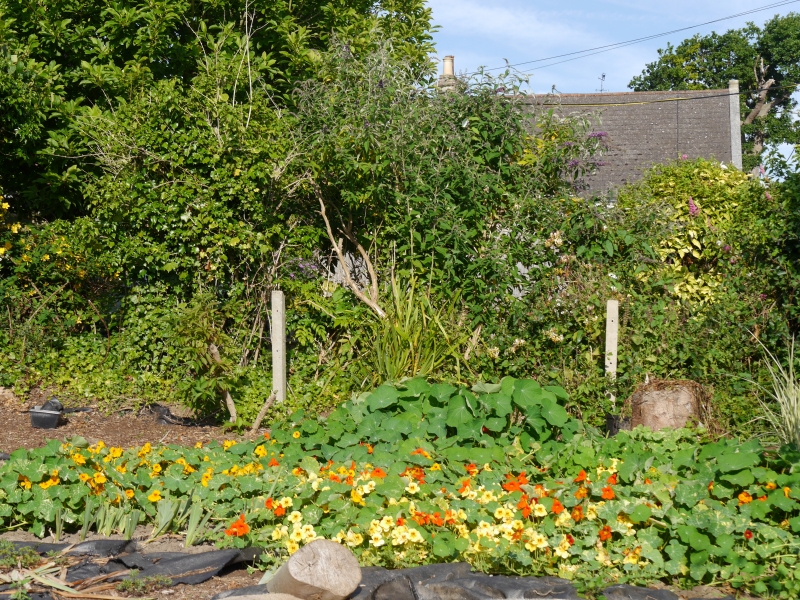 The front of the kitchen garden was a mass of nasturtiums that summer : almost smothering every annual weed bar a few; further back we started improving around the pond with additional pebbles and removed the carpet mulch beyond that as it had done its job.
The front of the kitchen garden was a mass of nasturtiums that summer : almost smothering every annual weed bar a few; further back we started improving around the pond with additional pebbles and removed the carpet mulch beyond that as it had done its job.
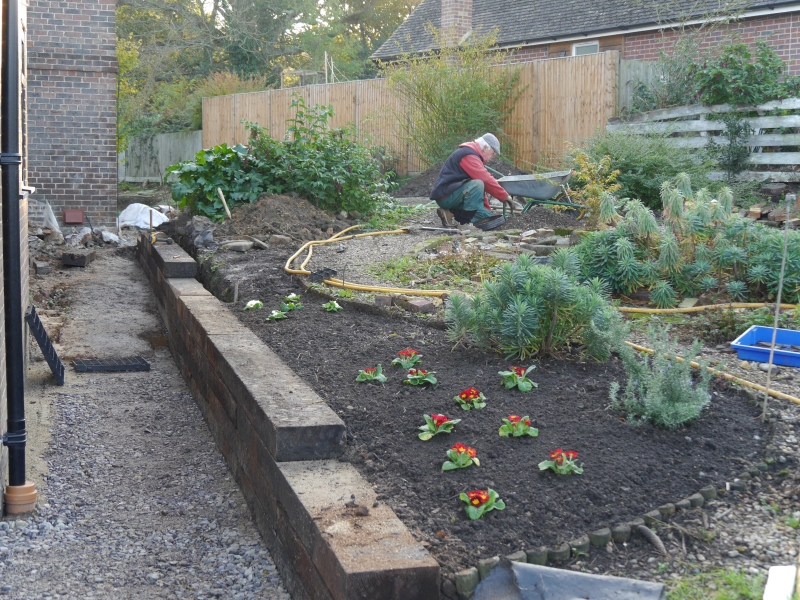 Next to the house a sleeper wall had been partially installed and the base for a new pathway [again partially] created.
Next to the house a sleeper wall had been partially installed and the base for a new pathway [again partially] created.
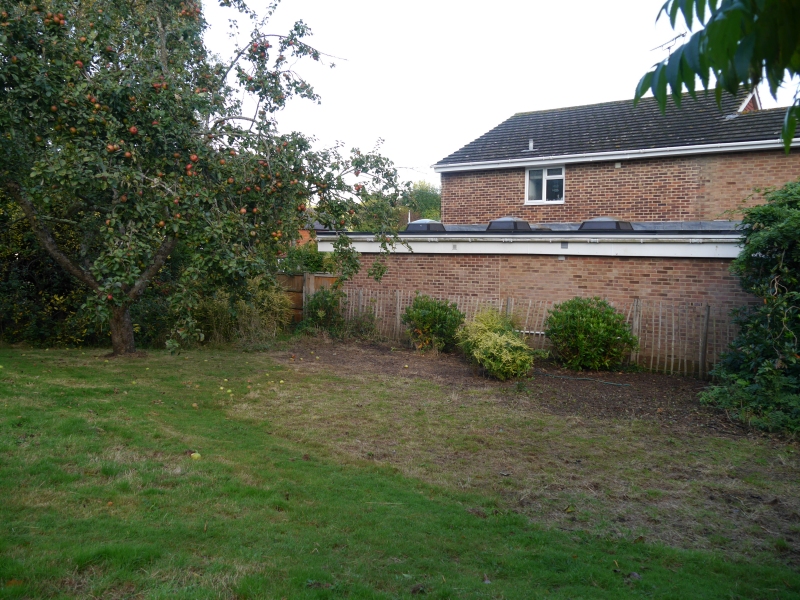 The east garden was designated a wild flower meadow for now with some close-cut paths flowing through it to emphasise the planned nature; the far northern end of the eastern boundary was looking much more controlled but the central boundary had still to be tackled; the small bed near the main entrance was now fully under control and we had dug over its twin on the east side of the drive.
The east garden was designated a wild flower meadow for now with some close-cut paths flowing through it to emphasise the planned nature; the far northern end of the eastern boundary was looking much more controlled but the central boundary had still to be tackled; the small bed near the main entrance was now fully under control and we had dug over its twin on the east side of the drive.
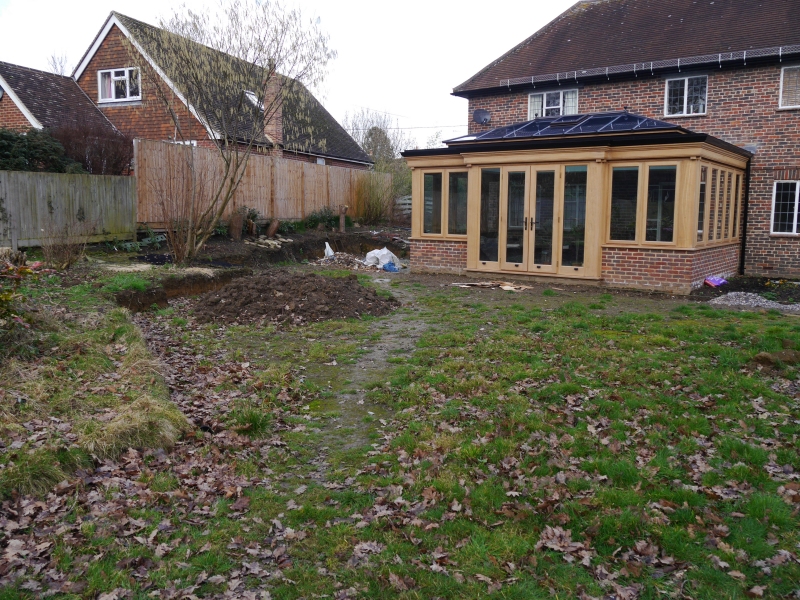 The biggest changes were in the southern garden where the land was partially sculpted when the orangery ground works took place; a patio area to the west of the orangery was identifiable with its sub-base in place [albeit partly covered in rubble!]; however, there was more levelling to do in order to achieve the end effect that we had, by then, planned : work for 2017.
The biggest changes were in the southern garden where the land was partially sculpted when the orangery ground works took place; a patio area to the west of the orangery was identifiable with its sub-base in place [albeit partly covered in rubble!]; however, there was more levelling to do in order to achieve the end effect that we had, by then, planned : work for 2017.
In terms of the glebe land, one needed to think of 'before Winter Stream' and 'after Winter stream'.
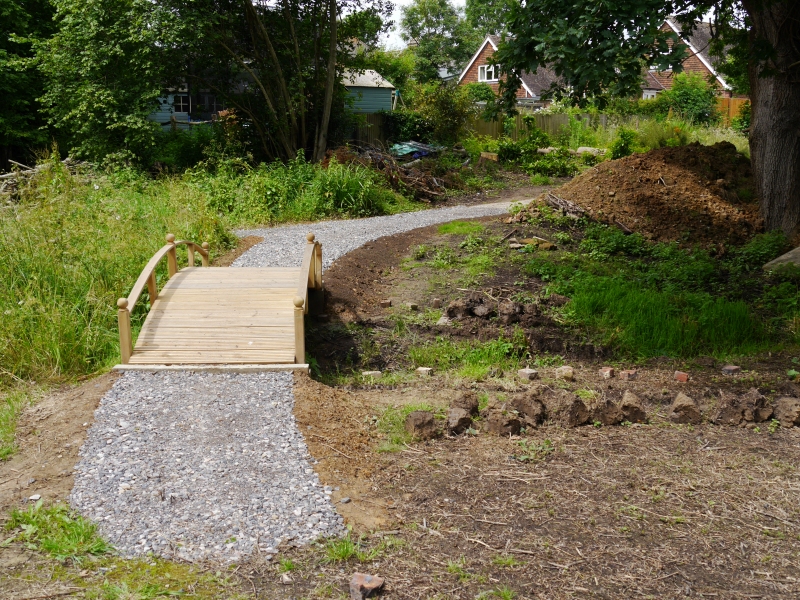 The two parts had been joined by a 'Chinese' bridge and plans were afoot to build a dam downstream of the bridge to make the stream look more like a river with a long elongated pond. Also on the stream, up at the crack willow, there was now a brick dam in place of the previous year's temporary log dam. During the year there was frog spawn and then tadpoles in the crack willow pond followed a bit later by a pair of mallard house-hunting [but it was not to their liking].
The two parts had been joined by a 'Chinese' bridge and plans were afoot to build a dam downstream of the bridge to make the stream look more like a river with a long elongated pond. Also on the stream, up at the crack willow, there was now a brick dam in place of the previous year's temporary log dam. During the year there was frog spawn and then tadpoles in the crack willow pond followed a bit later by a pair of mallard house-hunting [but it was not to their liking].
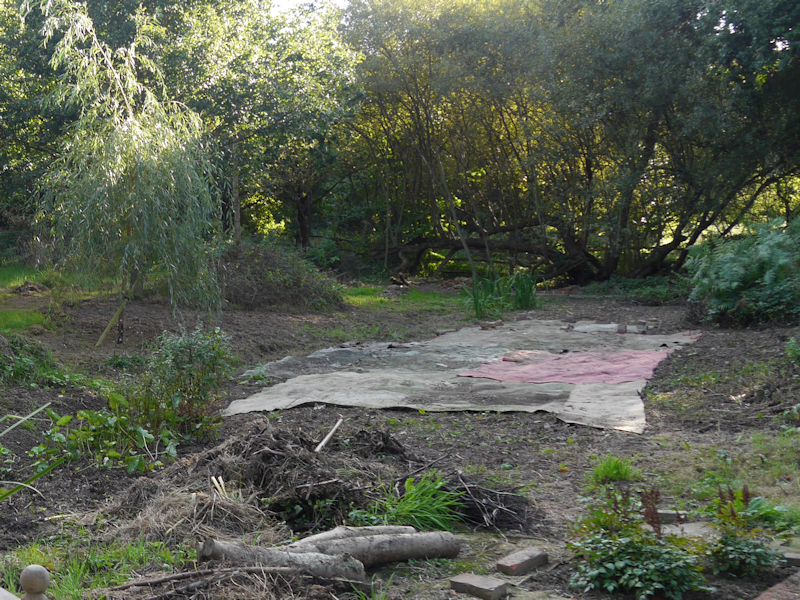 Work continued to disinfest the land of pernicious weeds on the house side of Winter Stream, particularly the hemlock water dropwort, reportedly the most poisonous plant in the UK! The carpets that were mulching the kitchen garden were now deployed along the banks of the stream but it would be a long job : the dropwort roots were deep and snapped easily and the bindweed roots were as thick as a pencil – and also broke off with ease.
Work continued to disinfest the land of pernicious weeds on the house side of Winter Stream, particularly the hemlock water dropwort, reportedly the most poisonous plant in the UK! The carpets that were mulching the kitchen garden were now deployed along the banks of the stream but it would be a long job : the dropwort roots were deep and snapped easily and the bindweed roots were as thick as a pencil – and also broke off with ease.
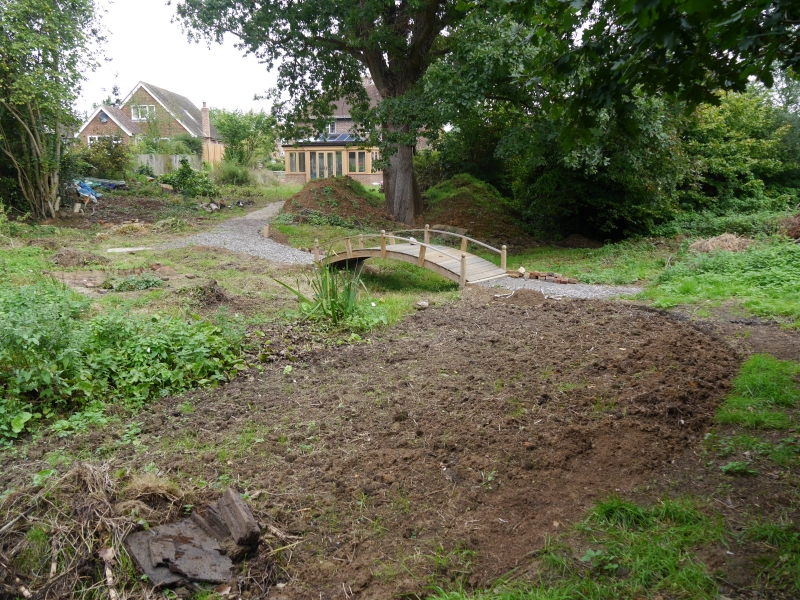 Other than the southern banks of Winter Stream which were being cleared as best we could, the rest of the glebe land was more or less being left alone other than thinning out the oaks which were close planted.
Other than the southern banks of Winter Stream which were being cleared as best we could, the rest of the glebe land was more or less being left alone other than thinning out the oaks which were close planted.
If you wish to see other garden pictures from this period they are available in the archive [opens a new tab] :
2017/18
The garden was again worked on continuously and it was very much a year for architectural garden work with lots of earth moving and construction. It wasn't all progress though with us losing control of some of the glebe land where work had started the previous year to clear the weeds. Bramble was [and still is!] amazingly resilient!
At the end of year two we had started to build the sleeper wall and path along the western walls of the house but were not sure what to do at the south end where a patio next to the orangery was the plan. Work had also started on the gravel bed around Top Pond and on the eastern bed of the entrance. As with the house, those work areas set the themes as spring encouraged a return to gardening drive. Later in the year the southern part of Home Garden, the area around Black Pond and the construction of the dam for the future River Pond at the Chinese Bridge became the main themes :
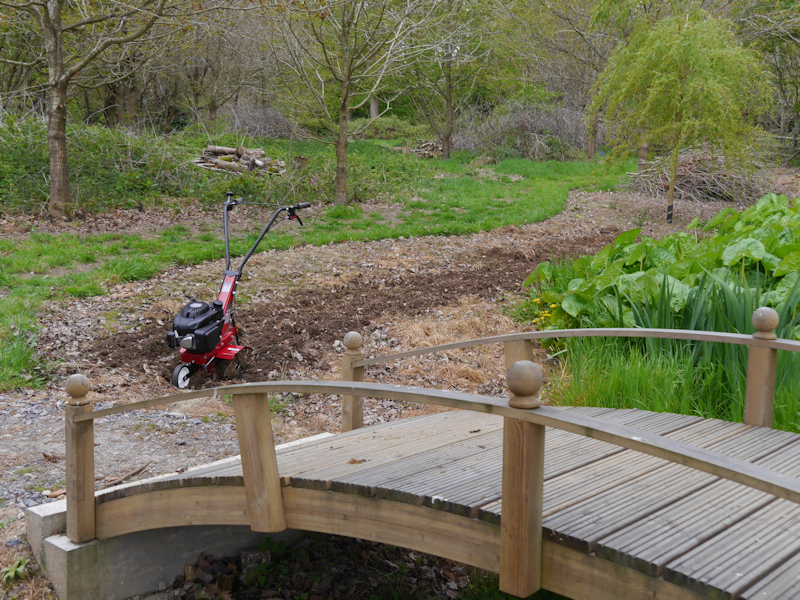 By the time spring arrived, the plans for the area around the orangery were clear so March and April saw the work progress on that front while the gravel at Top Pond was completed and the sleeper wall was extended towards the patio. A path across the front of the orangery was also started as that was to form the southern edge of the patio. Towards the end of April a new 'boys' toy' was acquired : a tilling machine to help keep control of areas reclaimed from nature.
By the time spring arrived, the plans for the area around the orangery were clear so March and April saw the work progress on that front while the gravel at Top Pond was completed and the sleeper wall was extended towards the patio. A path across the front of the orangery was also started as that was to form the southern edge of the patio. Towards the end of April a new 'boys' toy' was acquired : a tilling machine to help keep control of areas reclaimed from nature.
The picture on the right shows the tiller on its first outing turning over the bed immediately south of Winter Stream.
As with the house, the [paid] work plus international travel in May meant that little was achieved in the garden although a delivery of black pebbles for the paths around the house was received and the excavations around the patio were started.
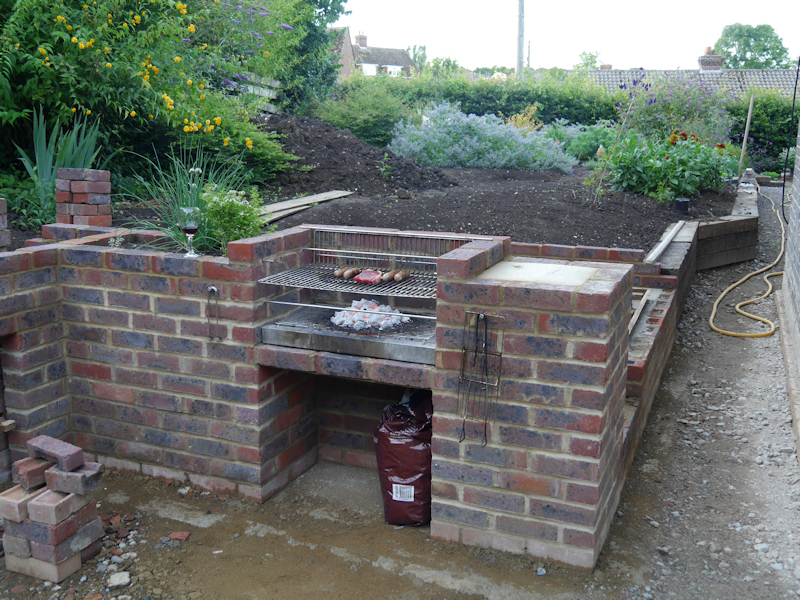
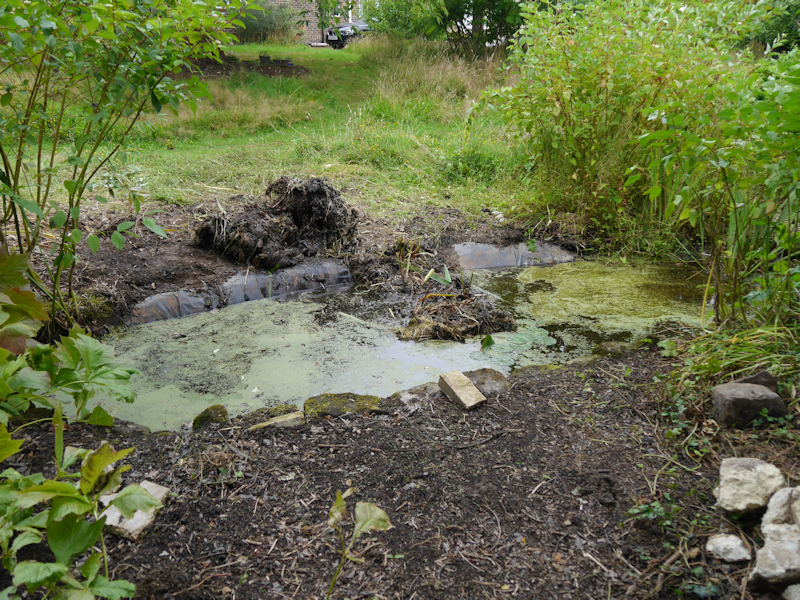 The theme for June and July was very much the patio and the associated brickwork for the braai [barbecue] and outdoor oven. Early June saw the foundations cast and then, almost immediately, Dave the brickie started work building up brickwork over the weekends. That work was finished by the end of July and we had already had our first braai, as can be seen in the picture on the left.
The theme for June and July was very much the patio and the associated brickwork for the braai [barbecue] and outdoor oven. Early June saw the foundations cast and then, almost immediately, Dave the brickie started work building up brickwork over the weekends. That work was finished by the end of July and we had already had our first braai, as can be seen in the picture on the left.
Not that the rest of the garden was neglected in those two months : we couldn't afford to do that. Of note was the effort that went into starting to recover Black Pond by removing the mass of iris growing in it. There was probably a total of 500 kg wet weight removed, some of which can be seen in the picture on the right. At the same time, a lot of effort went into clearing the scrub behind Black Pond up against the eastern fence and along the downstream banks of Winter Stream.
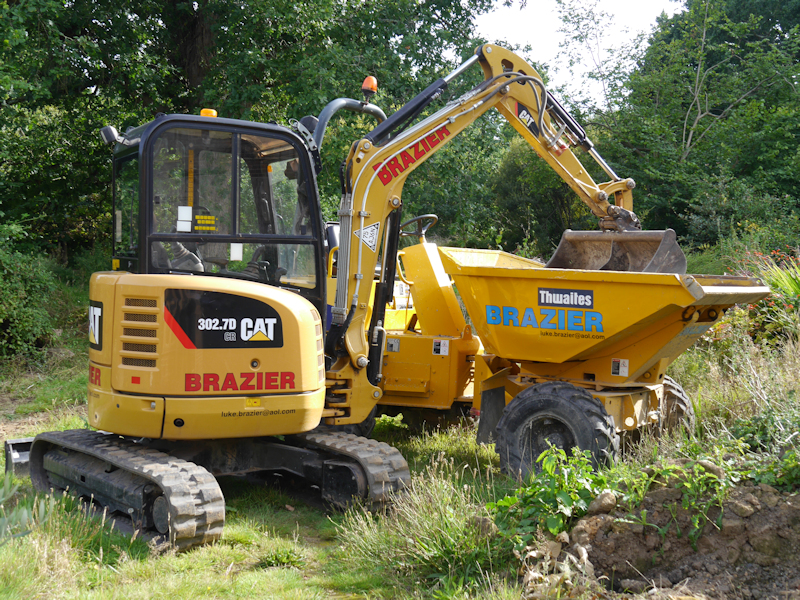 In August the theme moved to the southern garden and beyond as a 3 ton earth mover was hired for a week. That coincided with the delivery of the parts for the outdoor oven so the patio area was not totally neglected during the month!
In August the theme moved to the southern garden and beyond as a 3 ton earth mover was hired for a week. That coincided with the delivery of the parts for the outdoor oven so the patio area was not totally neglected during the month!
Earthmoving started down at Winter Stream below the Chinese Bridge to recover the lovely black topsoil and then form the banks of the future River Pond whilst also sorting out the earth dumps from the orangery work that had lain around the oak tree since then. After that the machine came up to the area immediately south of the orangery and completed the levelling for the future lawn. That created more clay piles on the north bank of Winter Stream but they would have to wait for another year to be dispersed.
It was actually into the first few days of September before the outdoor oven was ready for the drying out fires but by mid-September we had made the first pizzas.
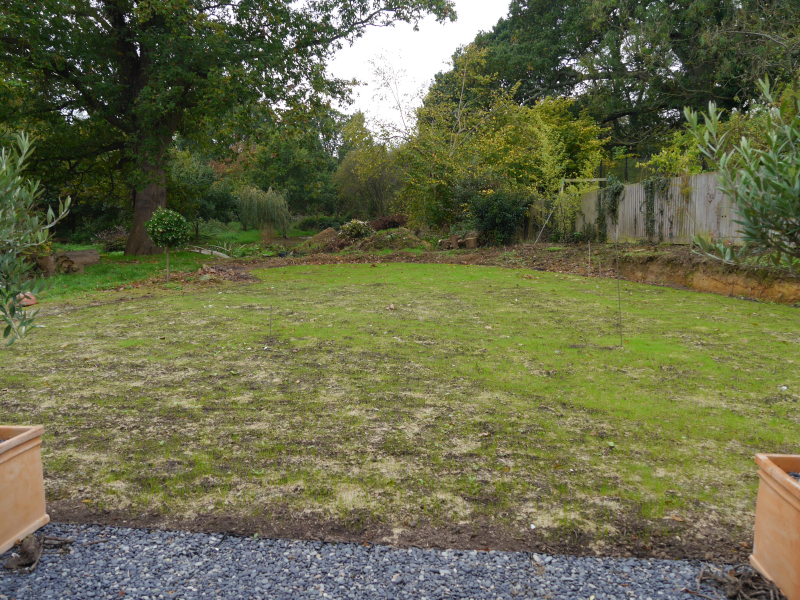 Most of September, however, was spent working on the future lawn to the south of the orangery. That allowed the grass seed to be sown in the first days of October and resulted in a good crop of grass by the time that winter arrived.
Most of September, however, was spent working on the future lawn to the south of the orangery. That allowed the grass seed to be sown in the first days of October and resulted in a good crop of grass by the time that winter arrived.
The picture on the left was taken just ten days after sowing the seed.
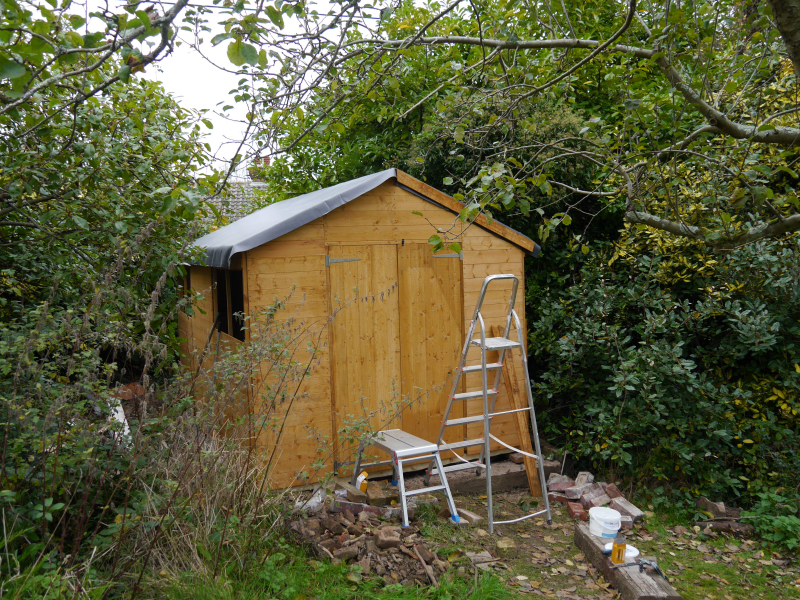 Much of the rest of the gardening year was spent on building a man cave [sorry, garden shed] in the unkempt area to the east of the driveway.
Much of the rest of the gardening year was spent on building a man cave [sorry, garden shed] in the unkempt area to the east of the driveway.
If you wish to see other garden pictures from this period they are available in the archive [opens a new tab] :
2018/19
This year's objectives for the garden, set in the third review, were to pave the patio, construct the western sleeper wall, complete the rockery and path to Chinese Bridge, complete River Pond, spread surplus clay and establish the main path. Most were achieved, thanks to the wonderful summer, but there was one spectacular failure and one extra objective added and achieved :
 Work on the establishment of the Formal Garden continued with a mix of architectural landscaping, planting and maintenance.
Work on the establishment of the Formal Garden continued with a mix of architectural landscaping, planting and maintenance.
Work on the sleeper wall along the western boundary was started right from the beginning of the period and was complete by mid-May. The sleepers lining the east of the formal garden were also extended to near the oak tree by that time.
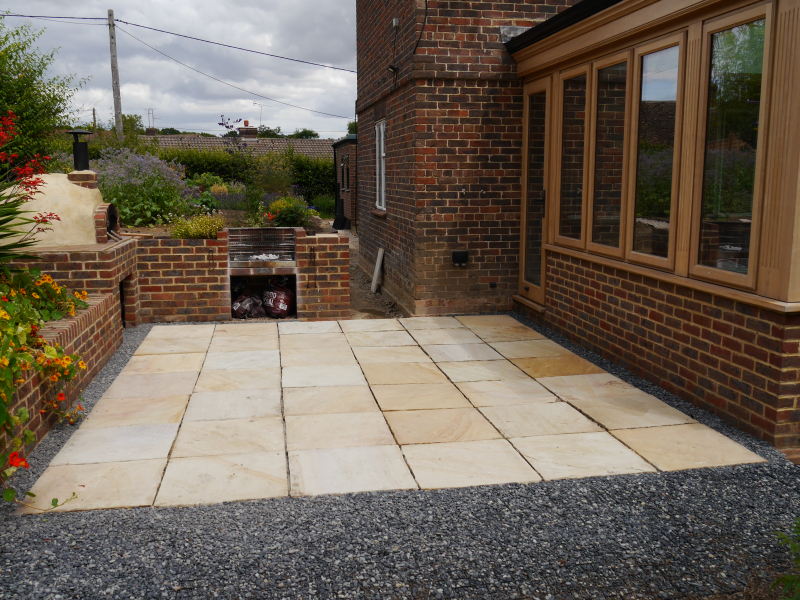
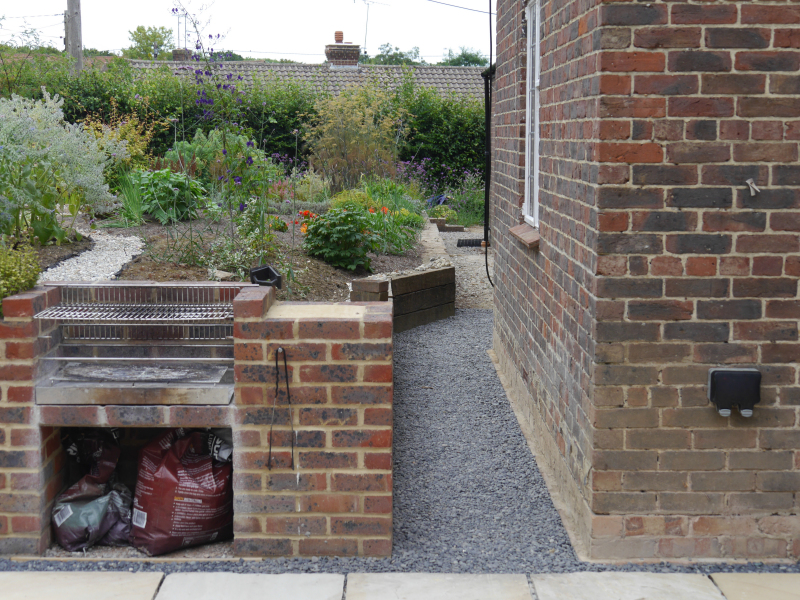 The paving of the patio [including the well top] was only started in early July but was finished within the month. What was not done was the building of a brick ring around the well head, a mental objective within 'pave the patio'. The problem is finding a way to cut every brick into a wedge [without upsetting the bank manager].
The paving of the patio [including the well top] was only started in early July but was finished within the month. What was not done was the building of a brick ring around the well head, a mental objective within 'pave the patio'. The problem is finding a way to cut every brick into a wedge [without upsetting the bank manager].
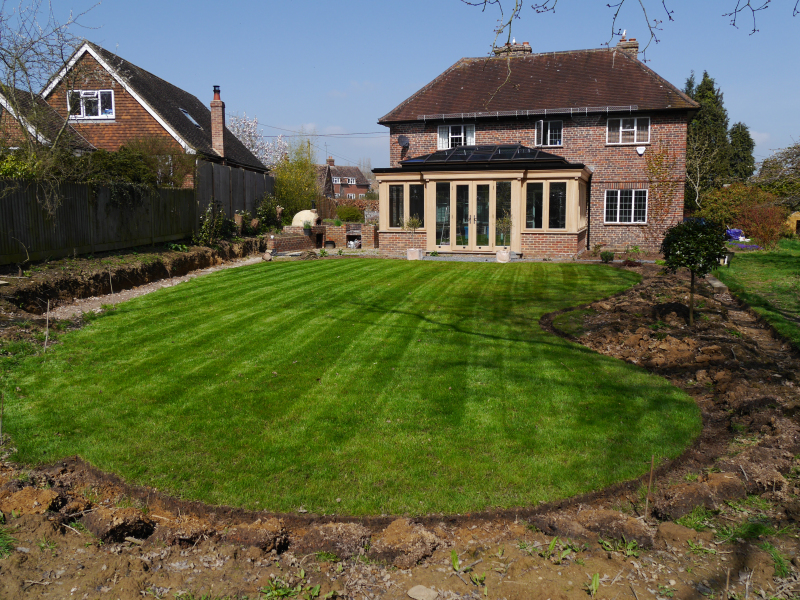
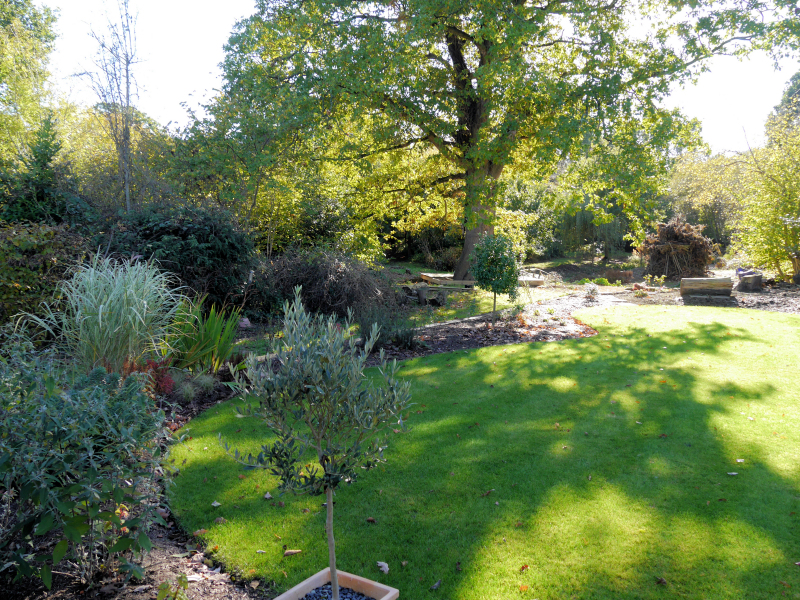 The first maintenance of the formal garden, of course, involved mowing, fertilising and weeding the lawn sown the previous autumn although the dry summer did slow the growth which reduced the mowing burden. Permanent planting progressed to some extent but much of the colour in 2018 was still annual planting. This was remedied towards the end of the year when more permanent planting – a mix of plants brought down from Chelsfield and new acquisitions – was undertaken.
The first maintenance of the formal garden, of course, involved mowing, fertilising and weeding the lawn sown the previous autumn although the dry summer did slow the growth which reduced the mowing burden. Permanent planting progressed to some extent but much of the colour in 2018 was still annual planting. This was remedied towards the end of the year when more permanent planting – a mix of plants brought down from Chelsfield and new acquisitions – was undertaken.
Other than the first part of the rockery, the North Glebe Garden was not really a garden at all at the start of the period although much [not all!] had been cleared of weeds. The first rockery stones had been placed but the path to Chinese Bridge had been more or less destroyed by the earth moving equipment in 2017 and planting was very limited. In addition, Winter Stream was a mess of weeds, particularly the marsh marigold section just above Chinese Bridge.
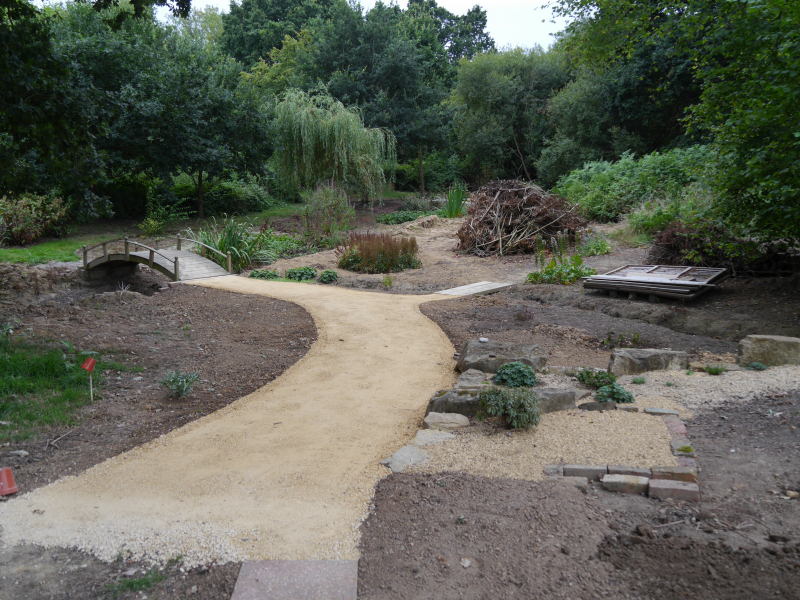 Work on this section of garden started once the patio was complete [so at the end of July] when the path was re-established using a golden self-binding gravel. It was quickly named the 'yellow brick road'.
Work on this section of garden started once the patio was complete [so at the end of July] when the path was re-established using a golden self-binding gravel. It was quickly named the 'yellow brick road'.
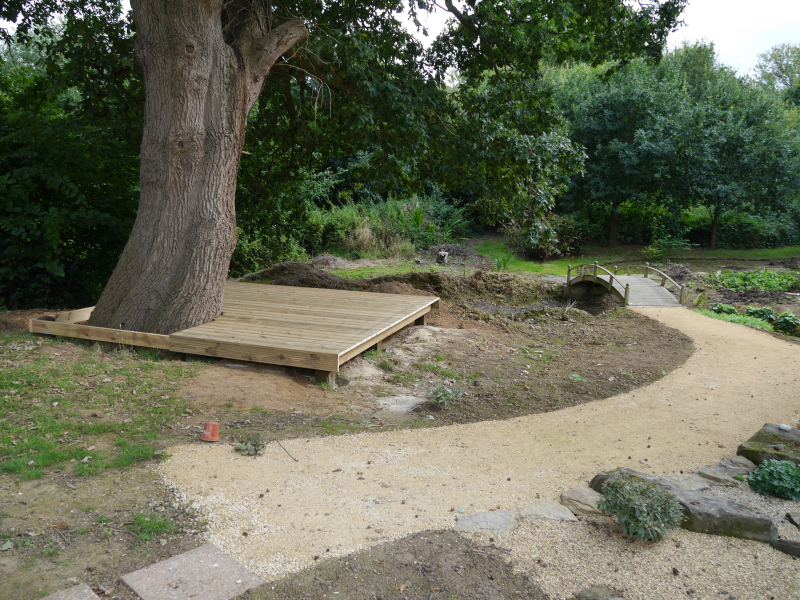 The next construction was a deck around the foot of the oak tree, undertaken in August. It wasn't even an objective for the period although it was on our thoughts almost from the start.
The next construction was a deck around the foot of the oak tree, undertaken in August. It wasn't even an objective for the period although it was on our thoughts almost from the start.
It is roughly four metres by four and allows one to sit out overlooking what will be River Pond one day.
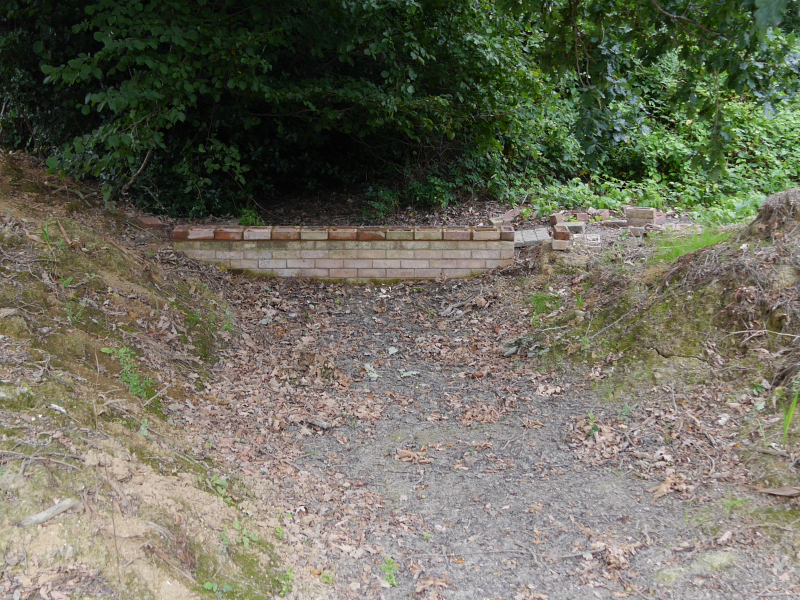
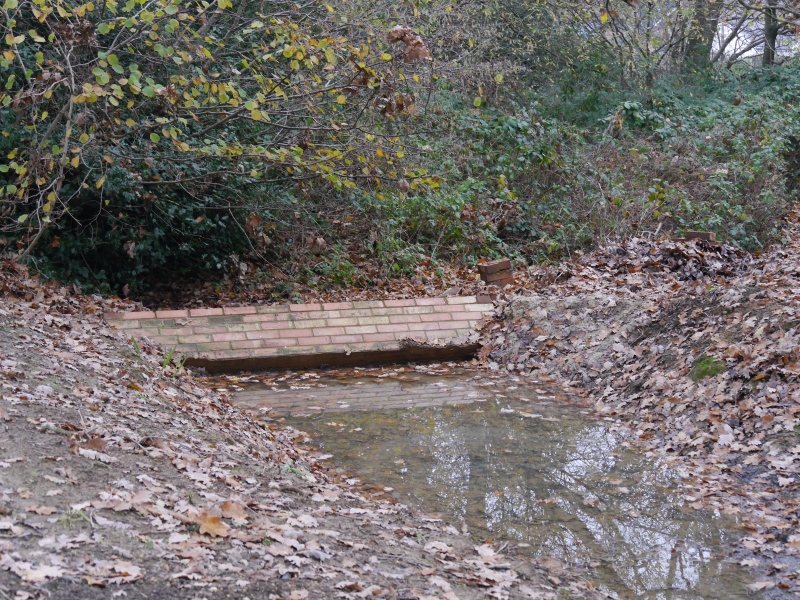 Which brings us to the dam needed to create River Pond. It had been started in 2017 and its impact on the water level noted in the winter of 2017/18. It was duly increased in height by two brick courses in August and we sat back to await the rains and the filling of the pond. The rains came with a vengeance in mid-November and the pond was full in no time – until the dam(n?) wall keeled over because of the water pressure. Yes, the wall was strong enough – it is still intact thanks to the mesh reinforcing layers that run along it – it just wasn't stable enough.
Which brings us to the dam needed to create River Pond. It had been started in 2017 and its impact on the water level noted in the winter of 2017/18. It was duly increased in height by two brick courses in August and we sat back to await the rains and the filling of the pond. The rains came with a vengeance in mid-November and the pond was full in no time – until the dam(n?) wall keeled over because of the water pressure. Yes, the wall was strong enough – it is still intact thanks to the mesh reinforcing layers that run along it – it just wasn't stable enough.
2019 would have be 'Robert the Bruce Year' [try, try and try again]. The thinking at the time was to have a weir under Chinese Bridge so that the dam didn't have to be so tall.
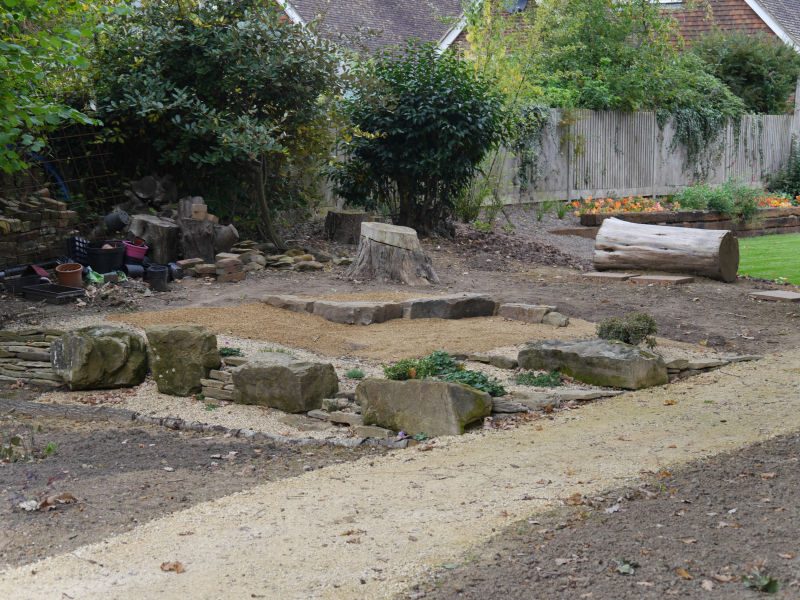 In early October some more rocks were added near the top of the rockery which allowed it to be declared complete in terms of architectural gardening. The planting and filling out of the original part of the rockery would have to wait until spring 2019.
In early October some more rocks were added near the top of the rockery which allowed it to be declared complete in terms of architectural gardening. The planting and filling out of the original part of the rockery would have to wait until spring 2019.
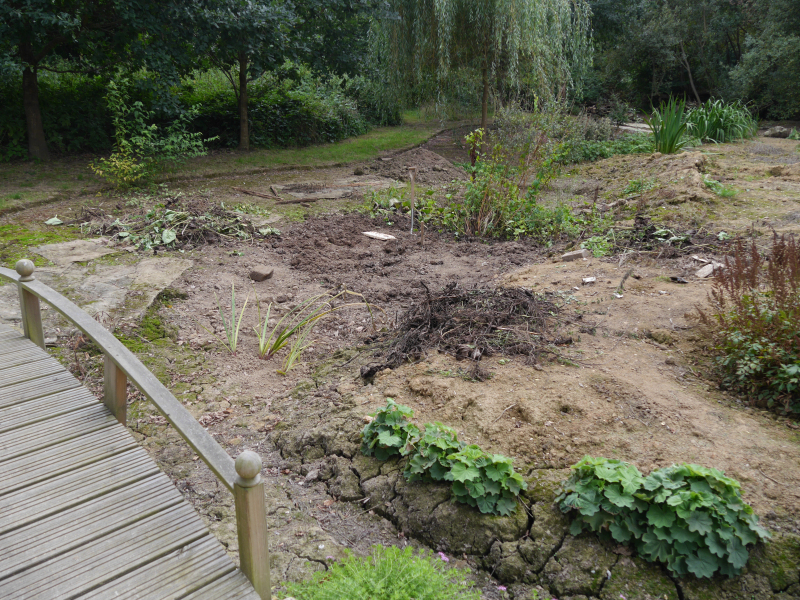
 Maintenance work in this part of the garden was woven between the architectural gardening throughout the summer. The clay mountains from the 2017 earthworks were spread across the north bank of Winter Stream and, after a dressing with bonfire ash, rotovated in. Weeding was, of course, continuous but required more or less architectural gardening effort in the bed of Winter Stream just to the west of the Chinese Bridge. Literally everything was dug out, including a fair amount of silt and then some of the irises and the water marigolds were replanted.
Maintenance work in this part of the garden was woven between the architectural gardening throughout the summer. The clay mountains from the 2017 earthworks were spread across the north bank of Winter Stream and, after a dressing with bonfire ash, rotovated in. Weeding was, of course, continuous but required more or less architectural gardening effort in the bed of Winter Stream just to the west of the Chinese Bridge. Literally everything was dug out, including a fair amount of silt and then some of the irises and the water marigolds were replanted.
One day in December saw an orgy of planting here [and elsewhere!]. Some under-planting had already occurred under the oak and that was now supplemented by groups of heucheras. Across the yellow brick road, a lot of primulas were planted on the banks of Winter Stream and, slightly further back from the stream, some astrantias and some Aruncus dioicus [Goat's Beard]. Astrantias are very promiscuous so only the deep red Astrantia major 'Rubra' were planted.
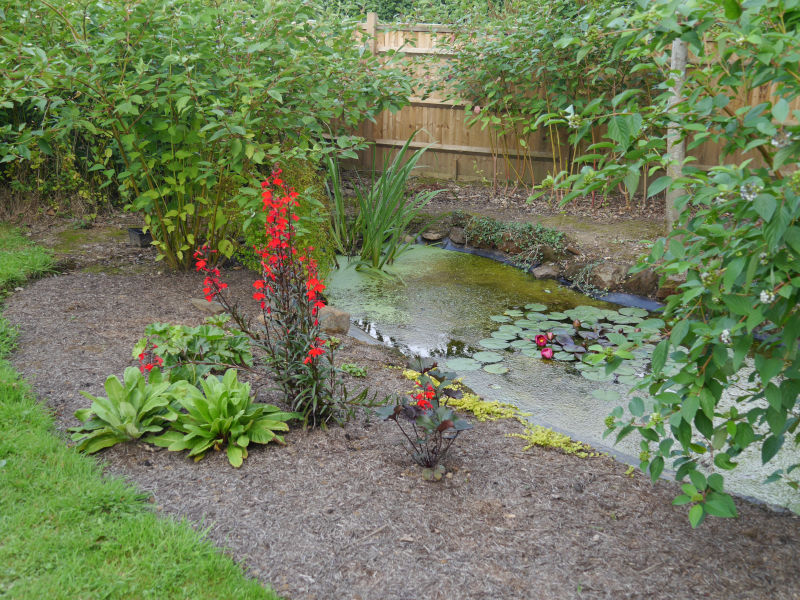 Work in the rest of the garden was relatively muted and limited to maintenance and planting. In the Wildflower Meadow the area down on the eastern boundary was further tamed with the last of the rhododendrons pruned fully, as was the yellow privet. That just left the section of the boundary bed further south between the privet and Black Pond : it was still a mass of cornus [red and green bark varieties] heavily contaminated with pernicious weeds. That would be a job for 2019.
Work in the rest of the garden was relatively muted and limited to maintenance and planting. In the Wildflower Meadow the area down on the eastern boundary was further tamed with the last of the rhododendrons pruned fully, as was the yellow privet. That just left the section of the boundary bed further south between the privet and Black Pond : it was still a mass of cornus [red and green bark varieties] heavily contaminated with pernicious weeds. That would be a job for 2019.
Towards the end of the year the bed along that border was planted with a Liquidamber styraciflua 'Slender Silhouette', two camellias, a yellow-leaved acer, a group of Cornus sanguinea 'Winter Flame' and a Cornus controversa 'Variegata' [ironically, right up against the mass of contaminated cornus].
The other work in the Wildflower Meadow included the continued planting up of the Black Pond west bed where a scarlet lobelia from 2017 [Lobelia cardinalis 'Queen Victoria'] lit up the bed for months on end in the summer. The bed should be even better in 2019. We also tackled the mass of sumac [Rhus typhina] just north of the cherry tree, reducing it down to a single stem. Despite appearances it was heavily infected with fungus so only time will tell if the one survives.
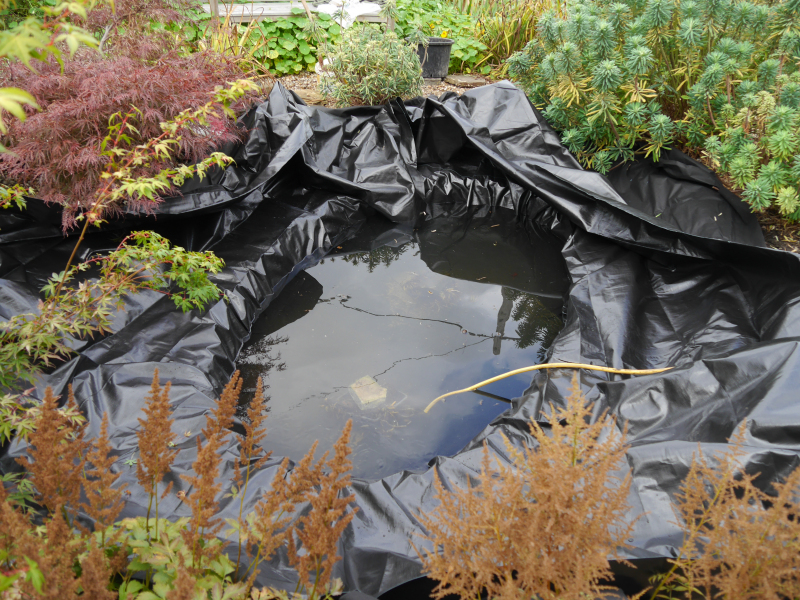 In the Kitchen Garden, we actually grew a few vegetables during the year, harvesting French beans for a long time because the weather was so favourable and plucking lettuce and spring onions as wanted. Having said that, it is wrong to think of it as a 'kitchen garden' as most of it is still ornamental, albeit of a relaxed [wild?] and self-sown form. At one point the area was mainly occupied by two swathes of borage and one of Verbena bonariensis. Between the two ran equally rampant nasturtiums, the grandchildren of an original sowing in 2016.
In the Kitchen Garden, we actually grew a few vegetables during the year, harvesting French beans for a long time because the weather was so favourable and plucking lettuce and spring onions as wanted. Having said that, it is wrong to think of it as a 'kitchen garden' as most of it is still ornamental, albeit of a relaxed [wild?] and self-sown form. At one point the area was mainly occupied by two swathes of borage and one of Verbena bonariensis. Between the two ran equally rampant nasturtiums, the grandchildren of an original sowing in 2016.
The only maintenance in this part of the garden was the ill-fated draining and re-lining of Top Pond in mid-October that resulted in the snapping of Mike's femur. The job would now have to be completed in 2019 but at least the new liner had stopped the leak, it was cosmetic work that was still required.
One highlight of the gardening year worth mentioning was the opening of the garden to visitors on the Peasmarsh Open Gardens day. [Being Inksons, we didn't serve tea and cake, we served Pimms!]. It was made clear that we didn't have a show garden, we had a work in progress and that as the years pass and visitors return they will see the [figurative] fruits of our labour.
If you wish to see other garden pictures from this period they are available in the archive [opens a new tab] :
2019/20
The objectives that we had set ourselves for the garden, recorded in the fourth review, were : establish the 'main road'; start again with River Pond; complete the well-head; complete the grey pebble path; finish planting in the formal beds; finish planting the deck bed; finish clearing the remainder of North Glebe; clear the last of Eastern Border; and [of course] carry on weeding, weeding, weeding ... One unstated objective but very much in our minds was to finish Top Pond which had been left 'as was' from when Mike's femur collapsed the day that the pond was re-lined.
In the event, some of the objectives were achieved and several additional ones were added and achieved too. The well head was not aso it was changed to a 2020 project.

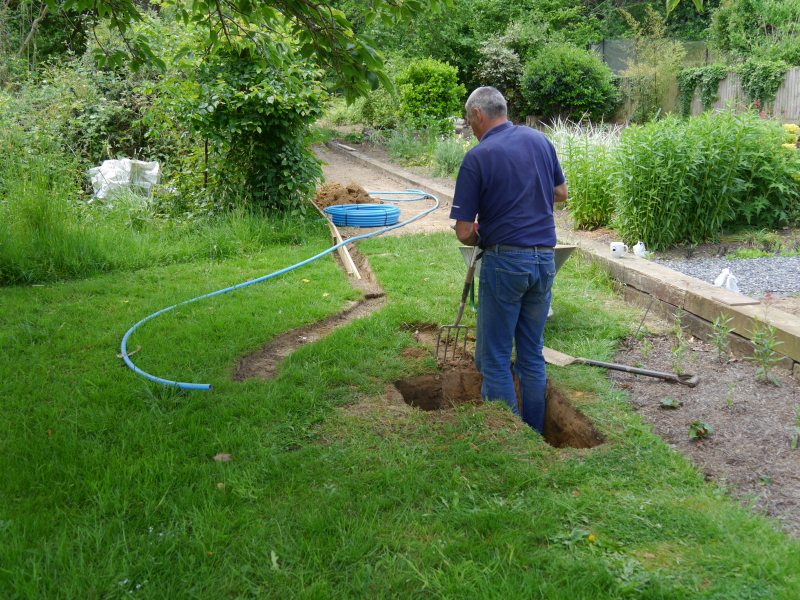 Work on the establishment of Main Road [the wide path from the drive right down to the oak where yellow brick road starts] was commenced at Easter.
Work on the establishment of Main Road [the wide path from the drive right down to the oak where yellow brick road starts] was commenced at Easter.
There had always been a thought that we should have a garden tap down at the Deck so an additional objective was created : to do just that before Main Road was finalised. In order to do that, we had to find the water main which entered the house under the orangery.
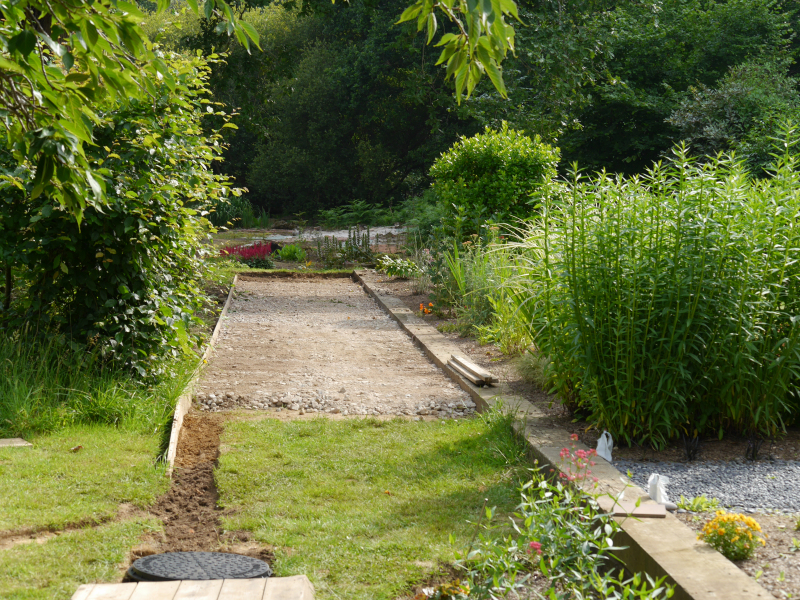
 By the end of June the sub-base of the road section between The Jungle and the formal garden was finished and the garden tap at the deck was operational [the picture on the right having been taken just before the tap was fitted].
By the end of June the sub-base of the road section between The Jungle and the formal garden was finished and the garden tap at the deck was operational [the picture on the right having been taken just before the tap was fitted].
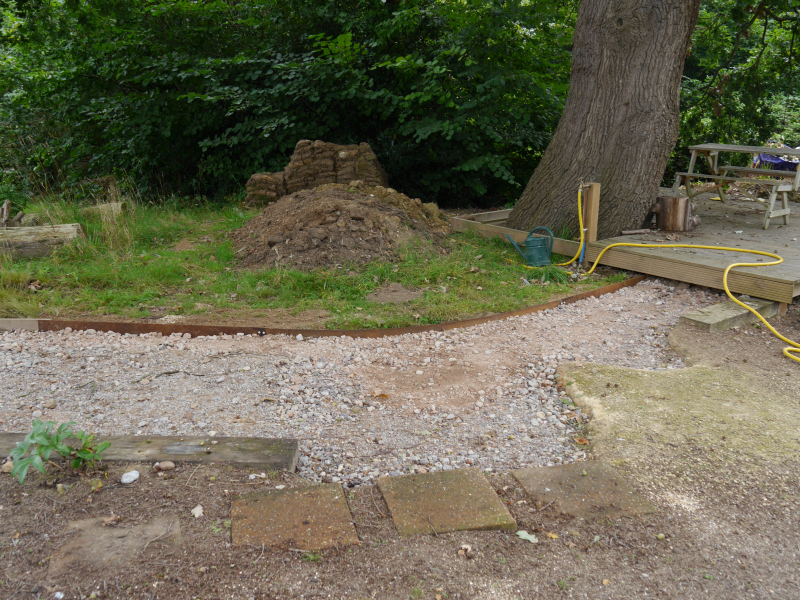
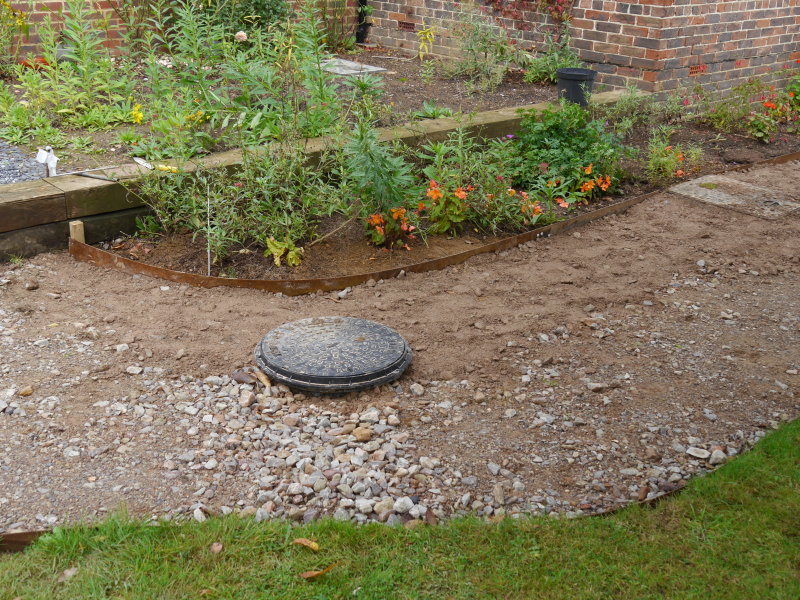 The edging of the road along The Jungle side was wood but to cope with the bends in the rest of the road it was decided to line with 'Corten' steel, a steel which rusts to a uniform extent and then stops corroding any further.
The edging of the road along The Jungle side was wood but to cope with the bends in the rest of the road it was decided to line with 'Corten' steel, a steel which rusts to a uniform extent and then stops corroding any further.
That meant a lot of tedious metalworking as it was only available in 2.5 metre lengths so one length was cut up to make 'fishplates' used to join lengths together. [Each fishplate had six holes so each joint had twelve holes to be drilled with some precision. Nylon nuts and bolts were used for the connections to avoid differential corrosion as Corten nuts and bolts are not available.]
The picture on the right was taken at the end of September when the final section of lining was installed.
In October the decision was taken to delay the top layer [of golden self-binding gravel] until the early spring. Because deliveries would only made from March onwards that meant that the road would only be completed in the 2020/21 period.
In the fourth report we noted the demise of the dam at what would ultimately become River Pond and the need for 2019 to be 'Robert the Bruce Year'. We decided that the new system would involve buttresses for the original dam and a weir under Chinese Bridge to get the full height / backward reach desired.
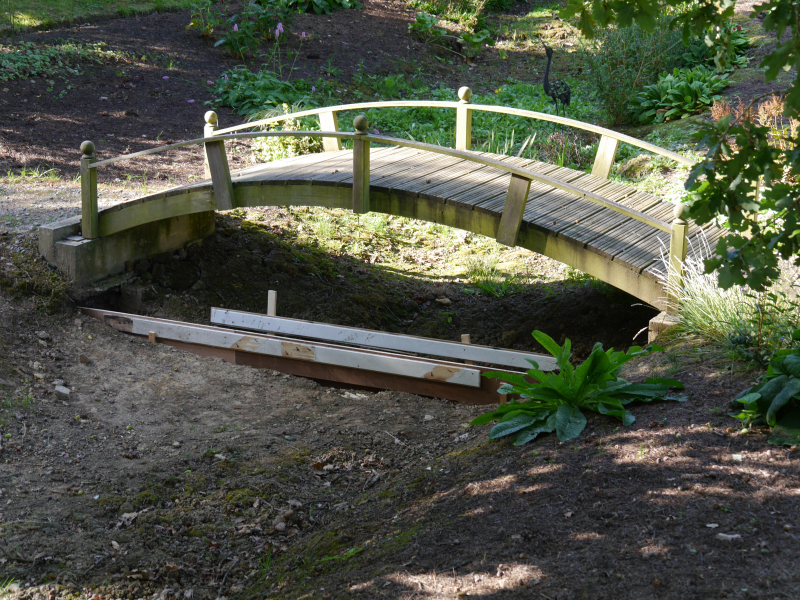 Early in the gardening year we found that the original dam could be righted easily, albeit not square on the foundation, but work did not really start until early September once the work on Main Road was easing off.
Early in the gardening year we found that the original dam could be righted easily, albeit not square on the foundation, but work did not really start until early September once the work on Main Road was easing off.
The dam was soon manhandled back into its final position with the help of some levers [thank you Archimedes] and then we started to excavate for the foundations. The buttress foundations were just holes in the ground but the weir foundation required a bit of shuttering.
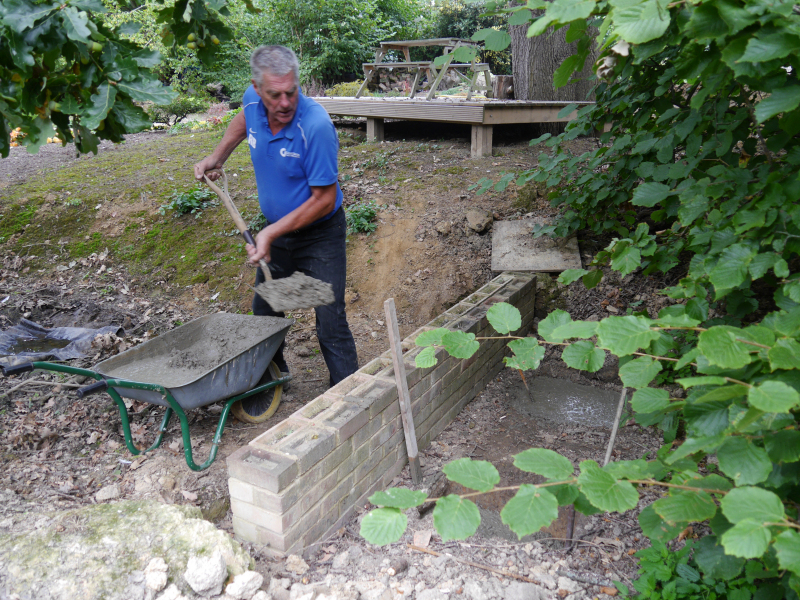
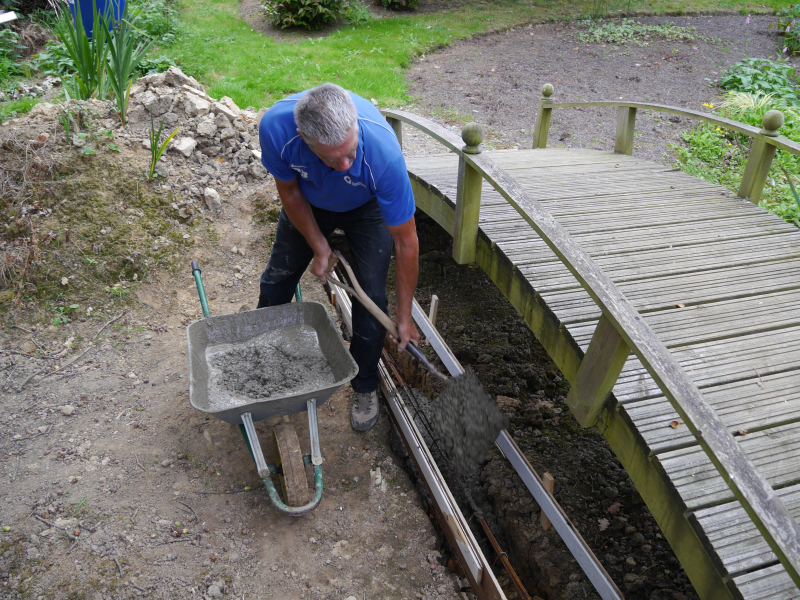 The foundations were all cast on September 16 in a morning of frenetic concrete mixing. Thank goodness that the mechanical mixer was available! [the original dam foundation was mixed by hand back in September 2016].
The foundations were all cast on September 16 in a morning of frenetic concrete mixing. Thank goodness that the mechanical mixer was available! [the original dam foundation was mixed by hand back in September 2016].
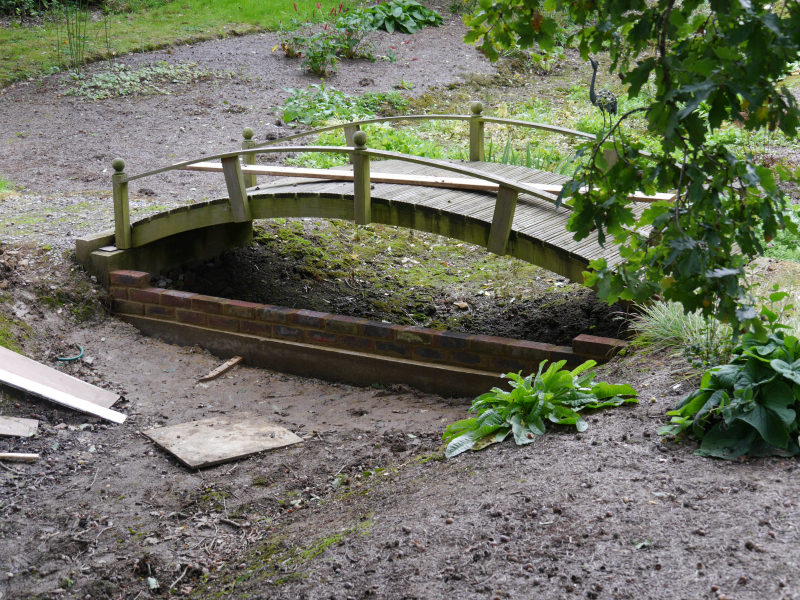
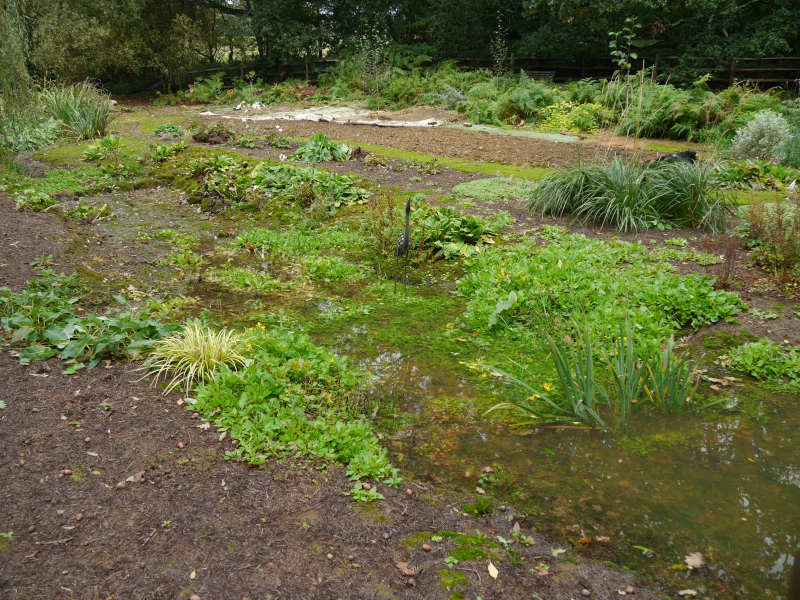 Two weeks later and the weir had been brought up to two courses in order to see the effect. The mortar left over had also been used to start the buttresses on the dam itself.
Two weeks later and the weir had been brought up to two courses in order to see the effect. The mortar left over had also been used to start the buttresses on the dam itself.
By mid-October it had rained sufficiently to fill behind the weir and it became clear that a third course was needed to get the depth and backward reach that we wanted.

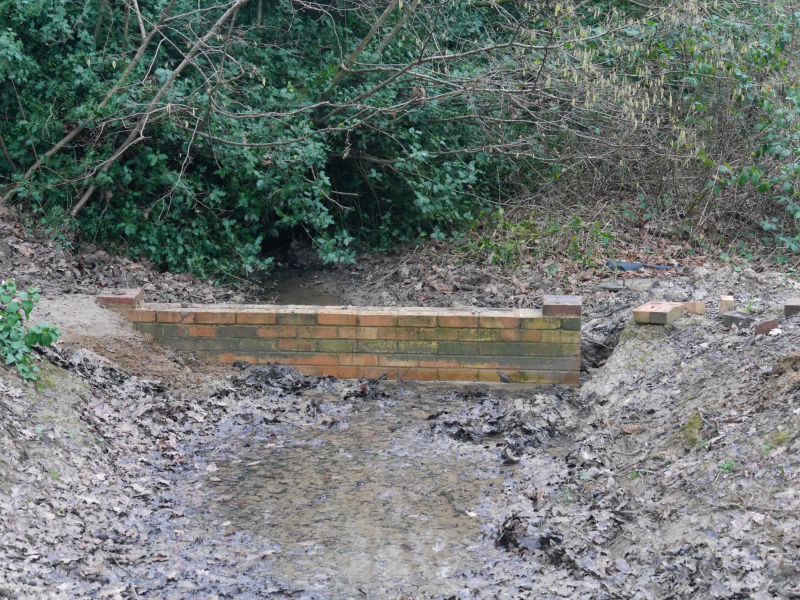 By mid-November the buttress of the dam had been cast, the torrent of Winter Stream being diverted around either side of the dam.
By mid-November the buttress of the dam had been cast, the torrent of Winter Stream being diverted around either side of the dam.
However, it was then early January before the weather was dry enough to tackle the first of the abutments, the northern one. Before the southern abutment could be started it would be necessary for the tile topping of the dam to be added [easier than trying to remove a course of bricks and re-laying them frog-down to avoid frost damage] and for another dry period to happen.

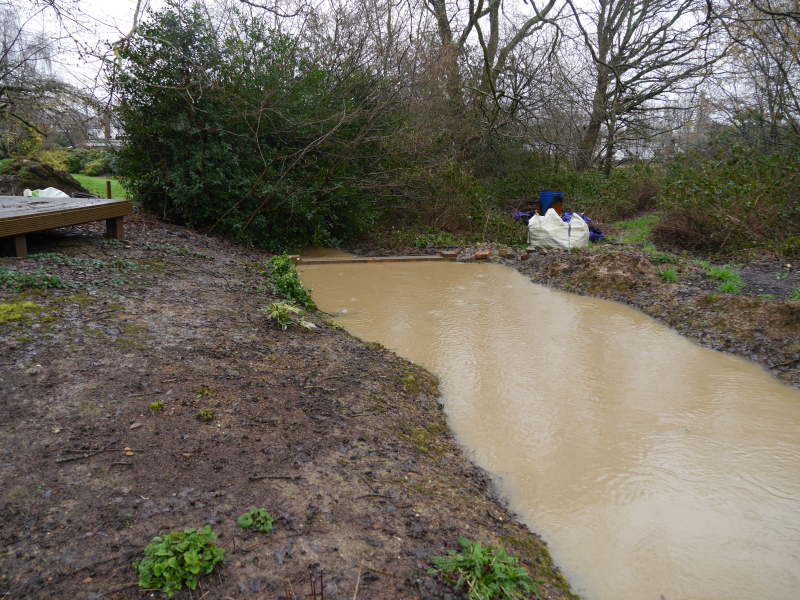 In early February the weather was good enough one day for the tiles to be laid but the land was so wet and the rain so persistent that the flow of Winter Stream never did ease off enough for us to contemplate building the south abutment. That was therefore delayed until the 2020/21 reporting period.
In early February the weather was good enough one day for the tiles to be laid but the land was so wet and the rain so persistent that the flow of Winter Stream never did ease off enough for us to contemplate building the south abutment. That was therefore delayed until the 2020/21 reporting period.
At the very end of the reporting period we had two heavy rain events in quick succession. The picture on the right shows that the flow of Winter Stream was so fast and brought down such debris that the future River Pond was nearly full so at least we knew that the new buttress behind the dam was up to the job!
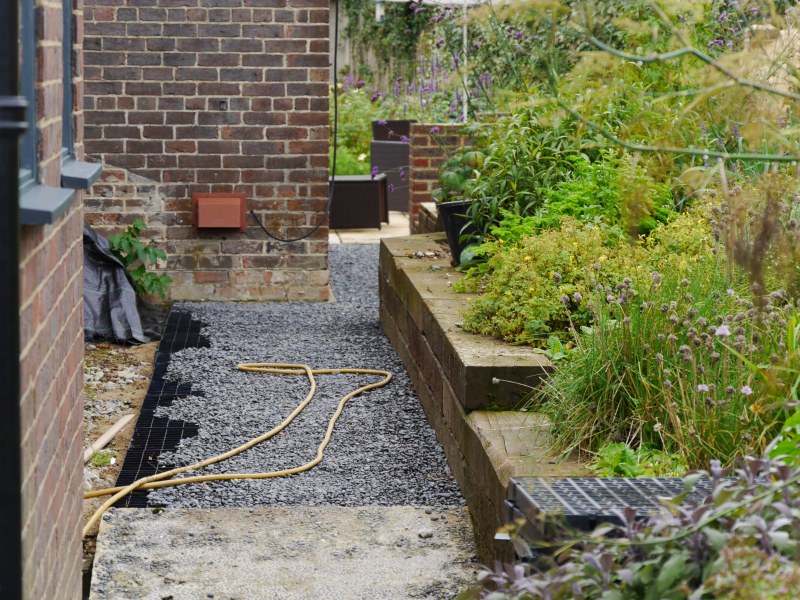 The Icelandic pebble path to the west of the house had not been worked on since mid-2018 when the section from the patio around to the corner of the lounge had been installed. It only took two hours one afternoon in late August to get the next section from there to the concrete slope installed and effectively filled. Another hour the next day finished the job.
The Icelandic pebble path to the west of the house had not been worked on since mid-2018 when the section from the patio around to the corner of the lounge had been installed. It only took two hours one afternoon in late August to get the next section from there to the concrete slope installed and effectively filled. Another hour the next day finished the job.
It was then decided that the final section [from the bottom of the slope to the north end of the building] should really be delayed until after the main structure of the secondary porch was completed.
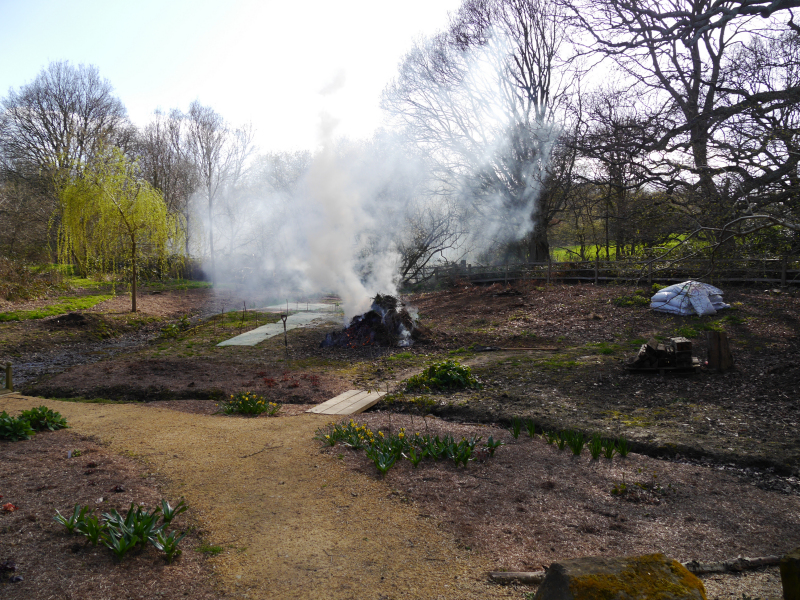 Work started again in the North Glebe in March, the section closest to Winter Stream having already been planted and the lowest part across the proposed stream path had been carpet mulched previously. The rest of the area was dug over to start the process of controlling the bindweed / brambles / bracken and the carpets were dragged one section upwards so that the line of the path could be defined.
Work started again in the North Glebe in March, the section closest to Winter Stream having already been planted and the lowest part across the proposed stream path had been carpet mulched previously. The rest of the area was dug over to start the process of controlling the bindweed / brambles / bracken and the carpets were dragged one section upwards so that the line of the path could be defined.
After that initial effort little time was devoted to the area for quite a while as other projects had priority and, of course, the weeds - particularly the bracken - grew back despite several weedkiller spraying sessions. Nonetheless, three Betula utilis 'Jacquemontii' [white barked birch], three magnolias, two ornamental brambles and an Acer palmatum 'Shaina' were planted in pockets hacked out of the bracken.

 It was actually early October before work picked up again here. By the that time the stream path had been well defined [in the picture on the left it showed green with moss growth]. The lowest section immediately north of it was rotavated and then generously dressed with compost which was, in turn, rotavated in. At the same time the path was dressed with wood chips.
It was actually early October before work picked up again here. By the that time the stream path had been well defined [in the picture on the left it showed green with moss growth]. The lowest section immediately north of it was rotavated and then generously dressed with compost which was, in turn, rotavated in. At the same time the path was dressed with wood chips.
By the end of October planting of this section was under way, something which continued through November.
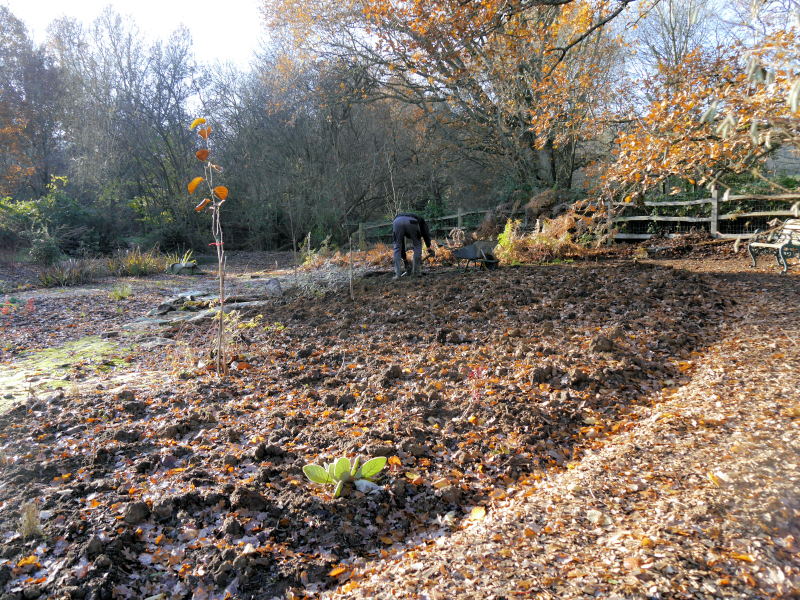 November also saw the start of the second assault on the bracken in the upper sections of the area. The carpets were left on the second section over winter with the expectation that they would be moved yet further up and the second section would be prepared for planting once the soil started to warm.
November also saw the start of the second assault on the bracken in the upper sections of the area. The carpets were left on the second section over winter with the expectation that they would be moved yet further up and the second section would be prepared for planting once the soil started to warm.
That was work planned for March 2020.
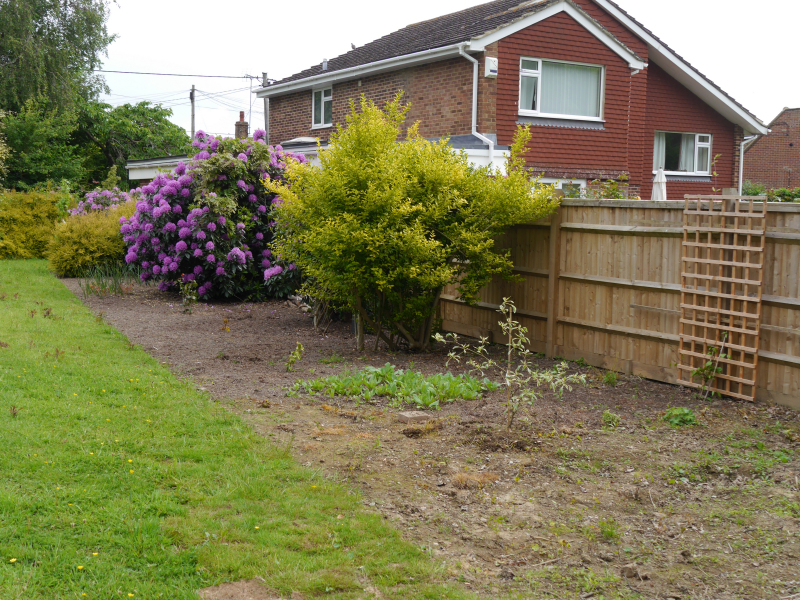
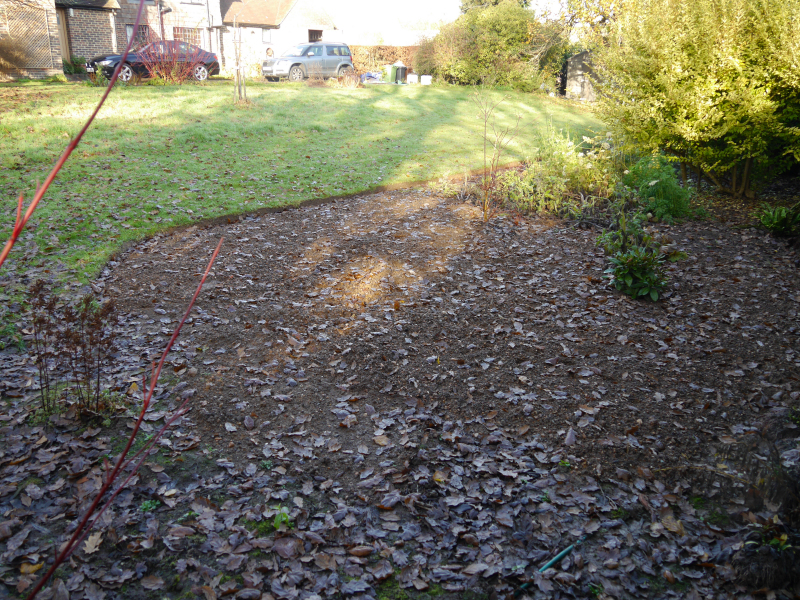 In the Eastern Border, we had previously cleared past the yellow privet but that still left the last section before black pond. By the end of May that had been cleared of the many suckered cornus shrubs and most of the pernicious weeds. It was then left fallow for the rest of the year to give the weeds a chance to regrow and be weeded out. Some of the cornus were replanted in South Glebe to give winter colour, others were given away and a lot were just burnt.
In the Eastern Border, we had previously cleared past the yellow privet but that still left the last section before black pond. By the end of May that had been cleared of the many suckered cornus shrubs and most of the pernicious weeds. It was then left fallow for the rest of the year to give the weeds a chance to regrow and be weeded out. Some of the cornus were replanted in South Glebe to give winter colour, others were given away and a lot were just burnt.
In the autumn the area was considered adequately clear so the edge of the grass was trimmed and some additional top soil was placed to try and raise the bed because it was close to waterlogged.
Some of the shrub planting was then undertaken but most will have to wait until 2020 [when there will also be a need to keep weeding!].
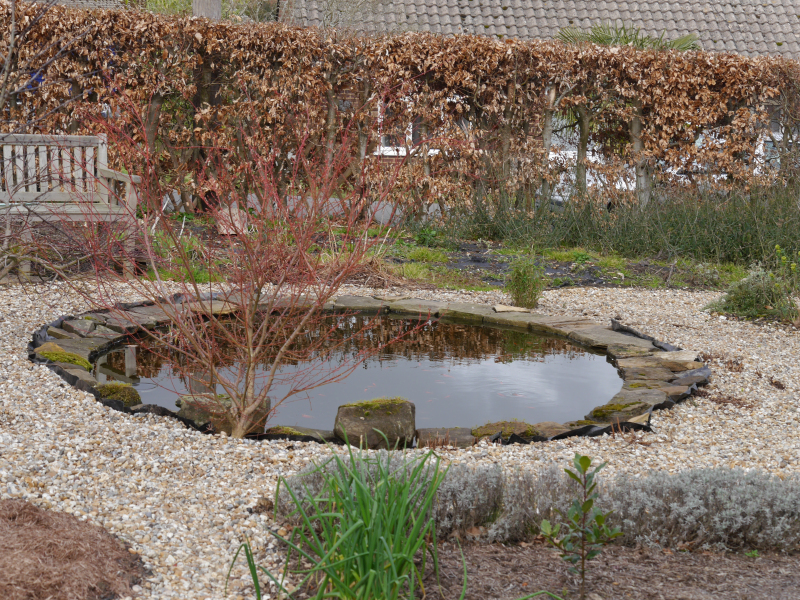
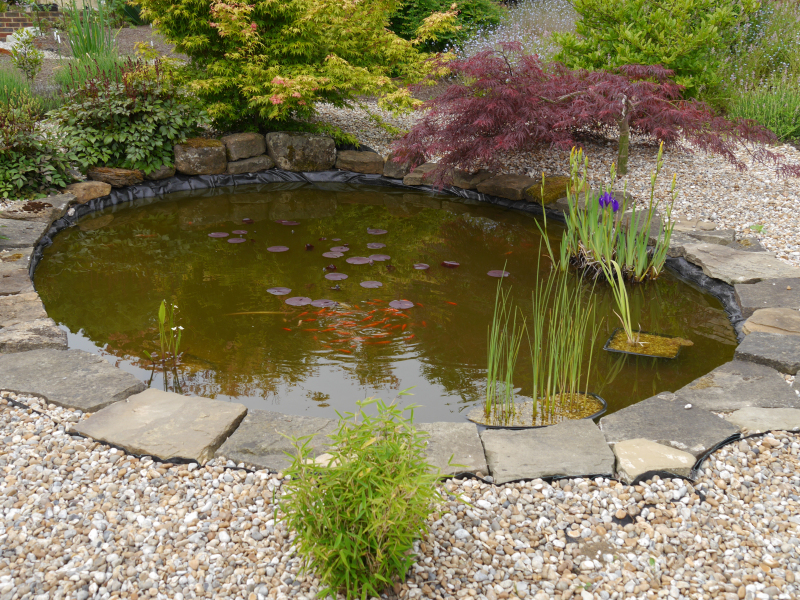 At Top Pond, it was early March when the work started again to tidy up the liner and reinstate the edging stones. The picture on the left was taken when only rough trimming was complete although some of the fine trimming had been done furthest from the camera.
At Top Pond, it was early March when the work started again to tidy up the liner and reinstate the edging stones. The picture on the left was taken when only rough trimming was complete although some of the fine trimming had been done furthest from the camera.
By the end of May, fine trimming long complete, new plantings both on the edge [a dwarf bamboo] and in the pond [various] were starting to develop along with the original plants.
The other objectives, added to the list and achieved, were the establishment of some compost enclosures under School Oak and the building of a log store alongside the garage.
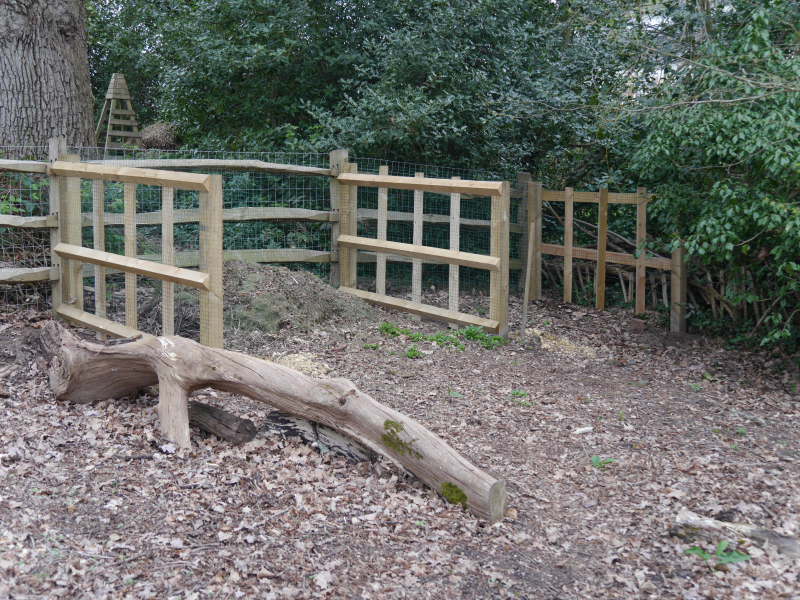 The compost enclosures were built in late March / early April using fencing posts and arris rails together with the original boundary fence. Two, very large, 'bins' were created.
The compost enclosures were built in late March / early April using fencing posts and arris rails together with the original boundary fence. Two, very large, 'bins' were created.
 The log store was built in May. It was not attached to the garage, it merely leans against it. The roof was made from featheredge fencing boards.
The log store was built in May. It was not attached to the garage, it merely leans against it. The roof was made from featheredge fencing boards.
If you wish to see other garden pictures from this period they are available in the archive [opens a new tab] :

